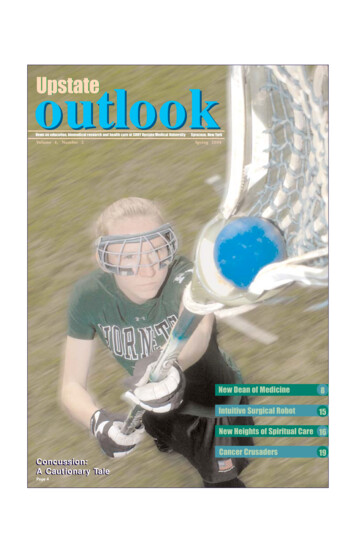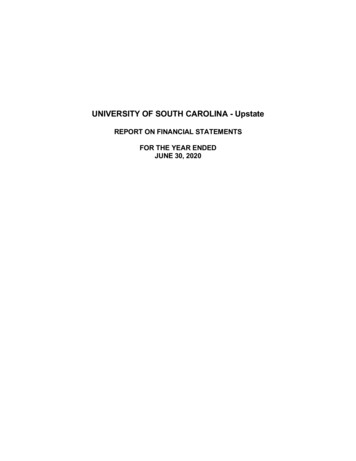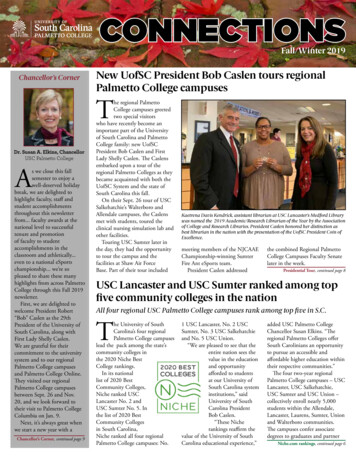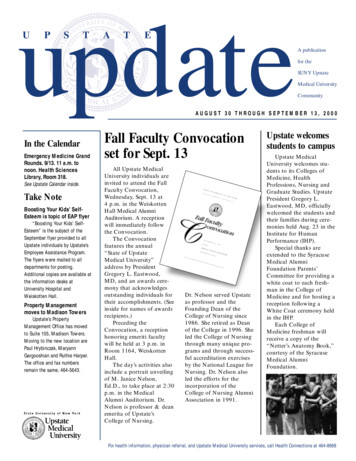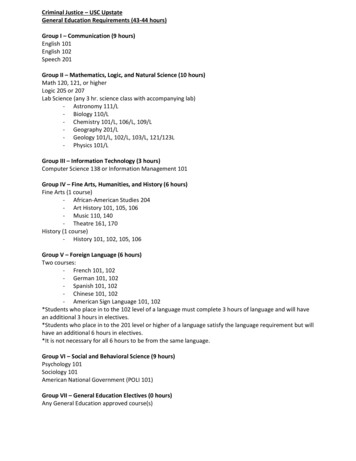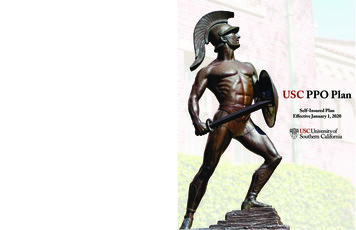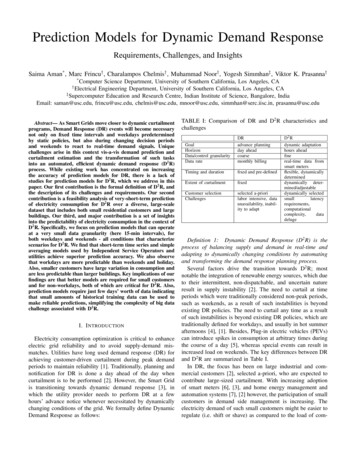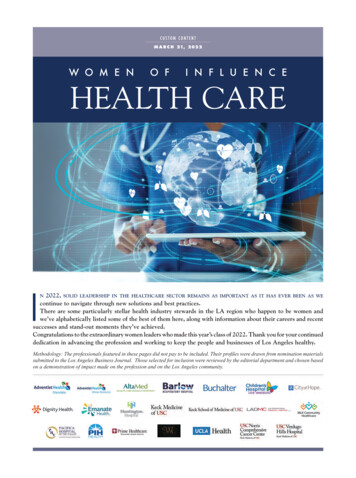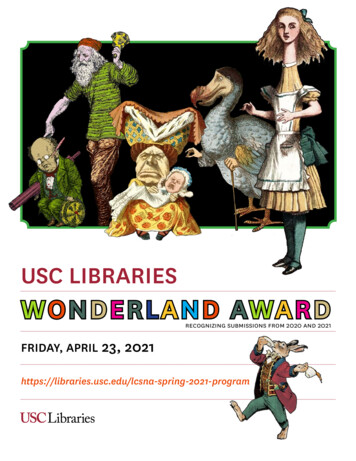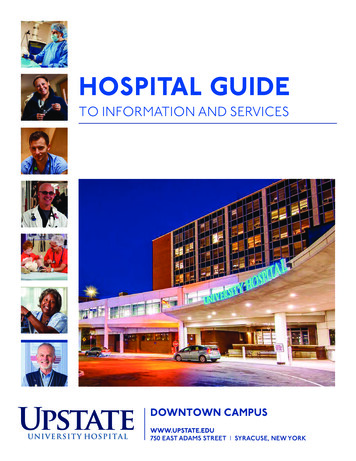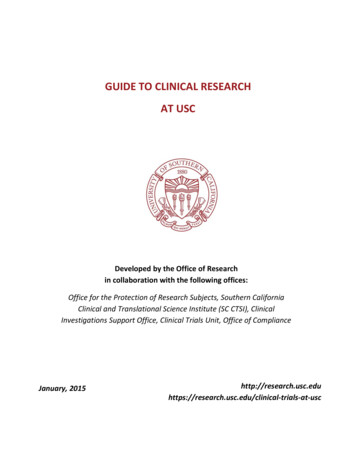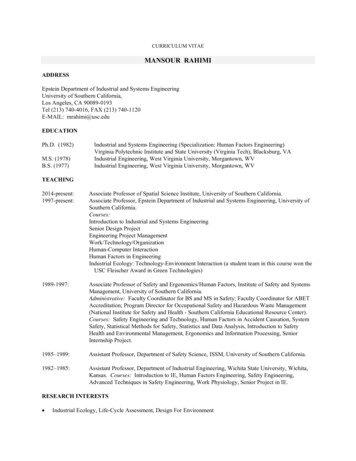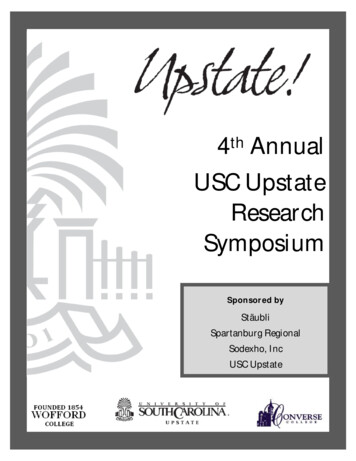
Transcription
4th AnnualUSC UpstateResearchSymposiumSponsored byStäubliSpartanburg RegionalSodexho, IncUSC Upstate
April 11th, 2008Message from the Program Committee:Welcome to the fourth annual meeting of the USC Upstate Research Symposium! The USC UpstateResearch Symposium Series offers faculty and students the opportunity to showcase their currentresearch, scholarly and creative activities while interacting with other researchers and community leadersfrom throughout the Upstate. This year’s meeting features presentations and posters from faculty andstudents from USC Upstate, Converse College and Wofford College, and is also attended by studentgroups from regional high schools and prominent business and community leaders.We would like to sincerely thank our sponsors: Stäubli (our GOLD Sponsor), SpartanburgRegional Healthcare System (our SILVER Sponsor), Sodexho, Inc., and USC Upstate. Suchsupport from prominent regional businesses and institutions is greatly appreciated and essential for theadvancement of academic research in the Upstate.This year’s Symposium includes an impressive list of Keynote Speakers, including Dr. John Stockwell,Chancellor of USC Upstate; Mr. Ingo Angermeier, President and CEO of Spartanburg Regional HealthcareSystem; Dr. Rosemarie Booze, Associate Vice President of Research of USC; and Dr. Michael Dorcas,Associate Professor of Biology, Davidson College.If you have any questions or comments about this Symposium Series, or would like to receive anadditional printed copy of the most recent Symposium Proceedings, please contact Dr. Sebastian vanDelden, (864) 503-5292, svandelden@uscupstate.edu. More information can also be found on theSymposium website: http://www.uscupstate.edu/symposium.Once again, welcome!The Program CommitteeSincere Thanks to our Gold and Silver Level Sponsors:The Stäubli Corporation is the Gold Level Sponsor for the Fourth Annual USCUpstate Research Symposium. Stäubli is a mechatronics solution provider withthree dedicated divisions: textile machinery, connectors and robotics. With aworkforce of over 3000, the company generates a yearly turnover surpassing 1billion Swiss francs. Originally founded 1892 as a small workshop in Horgen /Zurich, Stäubli today is an international group with its head office in Pfäffikon,Switzerland. Visit http://www.staubli.com for more information.The Spartanburg Regional Healthcare System is the Silver Level Sponsor forthe Fourth Annual USC Upstate Research Symposium. The Spartanburg Regional Healthcare Systemoffers a unique combination of world-class facilities, caring and dedicatedprofessionals, advanced technology and specialized treatment options.“Spartanburg Regional is more than a hospital, we’re are a family of healthcareproviders who live and work in the Upstate. We're here to care for you when youneed medical attention, but we're also here to help keep you well. We're yourhealthcare system, and we're with you for life.” Visit http://www.srhs.com formore information.S pon sor s: S taubli, S par ta n burgRegiona l, S odexh o, USCUpsta tePage 1
Fourth Annual USC Upstate Research SymposiumTable of ContentsThe Program Committee . 4Keynote Speakers . 5Symposium Schedule . 6Session I: Politics and Government. 9Facebook.com and MySpace.com: Critical Issues in Invasion of Privacy Laws . 9Chioma Ugochukwu, USC UpstateCivic Engagement in Adolescents: Engendering Civic Awareness through a . 11University Youth ProgramKerrie-Ann Wilkins, Jennifer Parker and Timothy Dale, USC UpstateBlack Panther Political Posters . 16James Risher and Rachel Snow, USC UpstateExecutive Outcomes in Sierra Leone and Beyond . 19Katherine King and William DeMars, Wofford CollegeSession II: Posters . 22Size-Frequency Distribution of Molluscs from a Pliocene Fauna, .22Florence, South CarolinaKatie Pruiksma, Sarah Campbell and Lyle Campbell, USC UpstateUSC Upstate Visual Resource Collection Development . 25Rachel Snow, USC UpstateSynthesis and Photochemical Reactivity of cis-hex-3-ene-1,5-diyne . 27Ryon Hamilton and Caleb Arrington, Wofford CollegeA Numerical Study on Eigenvibrations In Two-Material Structures . 29Jeremy Brown and Alex Timonov, USC UpstateRobot-Camera Orientation Recovery from the Optical Flow of High . 31Interest Points in an Unknown SceneFrank Hardy and Sebastian van Delden, USC UpstateLucid Echoes . 34Daniel Fowler and Ray Merlock, USC UpstateDiscriminating to Sell: Discrimination in Jewelry Stores . 36Jennifer Rayner and Kim Purdy, USC UpstateEffects of High vs Low Dose Caffeine on Temporal Perception . 39Dalene Prouty, Megan Burgette, Belda Thomas, Richard Keenand Neval Ertürk, Converse College2008 Senior Exhibition Catalog Design and Production . 42Stephanie Huskey, Gregory Bradham, Holly Coupe, Rachel Dickey,Brian Hefner, Veronica Lewis, Brandon Pendred, Derek Revan,and Lisa Anderson, USC UpstateS pon sor s: S taubli, S par ta n burgRegiona l, S odexh o, USCUpsta tePage 2
April 11th, 2008Hierarchical Clustering Support Vector Machines for Classifying . 43Type-2 Diabetes PatientsWei Zhong, Rick Chow, Richard Stolz, and Marsha Dowell, USC UpstateRelationship between the Leaf Age and Antioxidant Enzyme Activity .45Neval Ertürk and Barbaros Ertürk, Converse CollegeSession III: Healthcare . 49Evolving SVM Based Feature Selection Systems for Large Healthcare. 49DatabasesRick Chow, Wei Zhong, Michael Blackmon, Richard Stolz, and Marsha Dowell, USC UpstateInfluences of Leadership and Individual Differences on Nurses . 52Response to Hospital’s Change to Magnet StatusSteven Caldwell and Cathy Robey-Williams, USC UpstateSemiparametric Additive Competing Risks Model . 55Steve Hyun, Yanqing Sun and Rajeshwari SundaramUSC Upstate, UNC Charlotte, and The National Institute of HealthCourageous Caring: A Transtheoretical Exploration of Caring Science . 58and the work of Parker PalmerCindy Jennings and Gayle Casterline, USC UpstateSession IV: Manufacturing Issues and the Environment . 60Initial Steps to Voice-Guided Robotic Manipulation . 60Ben Overcash and Sebastian van Delden, USC UpstatePrevalence of the Large Liver Fluke, Fascioloides magna, in the . 63White-tailed Deer in South CarolinaEdna Steele, Converse CollegeInvestigation of the Genotoxicity of the Pesticide Sevin . 66Kimberly Shorter and Neval Ertürk, Converse CollegeAssessing the use of Artificial Structure in a Fragmented Landscape: . 69Herpetofauna as a Case StudyJared Ballenger, Lauren Horton, Will Reid and Melissa Pilgrim, USC UpstateSession V: Data Analysis and Pedagogy. 71Enhancing Reading Comprehension and Literacy in First-Year . 71College Students Through the Use of a Student-Led ConferenceAnthony DeClue, IDS Major, USC UpstateThe Magi’s Journey through Art: the Portrayal of the Magi in Kitsch Art . 73Elise Stuck and Teresa Prater, Converse CollegeTowards Generalization with Action Rules Mining . 76Angelina Tzacheva, USC UpstateReactions to Disappointing Performance Outcomes in Manufacturer- . 79Distributor RelationshipsAmy Cox, Converse CollegeS pon sor s: S taubli, S par ta n burgRegiona l, S odexh o, USCUpsta tePage 3
Fourth Annual USC Upstate Research SymposiumThe Program CommitteeDr. Sebastian van Delden, Symposium Chair, is an Assistant Professor ofComputer Science and the Director of the Center for Undergraduate Research andScholarship at USC Upstate. His research interests include Natural LanguageProcessing, Computer Vision and Robotics. He has published works in the Languageand Computers book series; The Journal of Data and Knowledge Engineering; TheInternational Journal of Artificial Intelligence Tools; the Lecture Notes in ArtificialIntelligence book series; and several peer-reviewed conferences.Ms. Susan Hodge is the Senior Director of Development in the Office ofAdvancement at USC Upstate. She holds degrees from Smith College, the Universityof Michigan, and Duke University (MBA), and a Certificate in Financial Planningfrom Western Carolina University. A native of Spartanburg, she worked in corporateand international banking in New York City with Chase, Dresdner, Fuji, andLPC/Reuters, and in Spartanburg with Wachovia. Her doctoral research area atMichigan was in early music.Dr. Peter Caster is an Assistant Professor of English at USC Upstate. His researchinterests include the study of race and gender in twentieth-century U.S. literatureand film. His articles have appeared in English Language Notes, The Drama Review,Papers of the Bibliographic Society of America, and Technology in the CollegeClassroom. He has also published a book entitled Prisons, Race, and Masculinity inTwentieth-Century U.S. Literature and Film and presented at numerous peerreviewed international and national conferences.Dr. Neval Ertürk is an Assistant Professor of Biology and the Co-director of CSI:Converse Summer Camps at Converse College. Her research interests includeincorporating research into teaching through development of innovative, inquirybased cell biology, genetics and biochemistry projects, investigating genotoxic effectsof pesticides in mammalian systems and investigating effects of abiotic stress onscavenging enzyme pathway. She is also a recent recipient of a Li-Cor GenomicsEducation grant for a DNA sequencer with AFLP capacity.Dr. Charles Reback is an Assistant Professor of Economics and Finance andDirector of the Center for Economic and Community Development at USC Upstate.His research interests include financial economics and economic history. His currentresearch projects include the impact that stadium naming rights have on companies’stock market performance, gender difference in risk aversion on the television gameshow Jeopardy!, and racial discrimination in late 19th and early 20th century realestate transactions. He has published research in Essays in Economic and BusinessHistory, and several conference papers.Dr. Caleb Arrington is an Associate Professor of Chemistry at Wofford College.His research interests involve understanding the photochemistry of smallconjugated hydrocarbons. This work is primarily done by studying photochemicalchange in a low-temperature (20 K) environment. By observing the reactivity ofmolecules at low temperature the fast first steps of polymerization reactions at roomtemperature can be isolated and better understood.S pon sor s: S taubli, S par ta n burgRegiona l, S odexh o, USCUpsta tePage 4
April 11th, 2008Keynote SpeakersDr. John Stockwell, Chancellor of the University of South Carolina Upstate. Dr.Stockwell has served as Chancellor of the University of South Carolina Upstate since1994, leading the University toward its vision as one of the leading metropolitanuniversities in the Southeast. Chancellor Stockwell is leading the University towardcompletion of a 10-year master plan, approved by the USC Board of Trustees in1997, including multi-million dollar capital developments in classroom space,academic support facilities, housing, and athletics facilities. In addition, a number ofcampus beautification initiatives are underway, as is a 60 million highwayinfrastructure project surrounding and intersecting the campus.Mr. Ingo Angermeier, President and CEO of the Spartanburg RegionalHealthcare System. Mr. Angermeier has more than 25 years of experience in healthcare and is a master's prepared Fellow of the American College of HealthcareExecutives. He has had experience in both general and teaching hospitals and multispecialty group practices both in urban and rural settings. From 1995 to March2001, he worked as CEO at Louisiana State University Medical Center. He was alsoan assistant dean and professor there. Prior to this, he was system executive vicepresident and chief administrative officer at Saint Francis Hospital in Tulsa,Oklahoma; executive vice president of St. Francis Hospital and Medical Center inTopeka, Kansas; associate administrator/chief operating officer of Salina RegionalMedical Center in Salina, Kansas; and senior vice president/chief operating officerof Creighton-St. Joseph Hospital in Omaha, Nebraska.Dr. Michael Dorcas, Associate Professor of Biology at Davidson College. Dr.Dorcas was awarded the 2004 Environmental Educator of the Year in NorthCarolina by the North Carolina Wildlife Federation. Dr. Dorcas' research programfocuses on the physiology, ecology, and conservation of amphibians and reptiles.During the last ten years, he has collaboratively secured substantial federal grantmoney to fund his research projects. His research program is interdisciplinary innature and relies heavily on collaboration with students. Dr. Dorcas has publishedseveral book chapters and over 60 articles on the biology of amphibians and reptiles,the most recent of which include students as coauthors. His recent books include, AGuide to the Snakes of North Carolina, Davidson College, and Snakes of theSoutheast, University of Georgia Press.Dr. Rosemarie Booze, Associate Vice President for Research at the University ofSouth Carolina. Dr. Booze also holds the Bicentennial Chair of BehavioralNeuroscience in the department of psychology. Her research focuses on how thecentral nervous system adapts to injury and disease, delving into topics that includehow stimulants affect the developing male and female brain, how the HIV virus andcocaine interact in the brain, the neurological basis of ADHD and the long-termconsequences and mechanisms of early brain injury.S pon sor s: S taubli, S par ta n burgRegiona l, S odexh o, USCUpsta tePage 5
Fourth Annual USC Upstate Research SymposiumThe Fourth Annual USC Upstate Research SymposiumSYMPOSIUM SCHEDULECLC Ballroom, USC :00pm8:00am-8:30am8:30am-8:40amRegistration / Sign InPoster SetupOpening Remarks, Dr. Sebastian van Delden, Symposium Chair8:40am-9:00amWelcome AddressDr. John Stockwell, Chancellor USC Upstate9:00am-10:00amSession I: Politics and GovernmentSession Chair: Dr. Timothy Dale, Assistant Professor of Political ScienceFacebook.com and MySpace.com: Critical Issues in Invasion ofPrivacy LawsDr. Chioma Ugochukwu, Assistant Professor of Journalism, USC UpstateCultivating Citizens through Community Outreach: Engendering CivicAwareness in a University Youth ProgramKerrie-Ann Wilkins, Psychology Major, USC UpstateBlack Panther Political PostersJames Risher, Graphics Design Major, USC UpstateExecutive Outcomes in Sierra Leone and BeyondKatherine King, Government Major, Wofford College10:00am-11:00amSession II: PostersSize-Frequency Distribution of Molluscs from a Pliocene Fauna,Florence, South CarolinaKatie Pruiksma, Biology Major, USC UpstateUSC Upstate Visual Resource Collection DevelopmentDr. Rachel Snow, Assistant Professor of Art HistorySynthesis and Photochemical Reactivity of cis-hex-3-ene-1,5-diyneRyon Hamilton, Chemistry Major, Wofford CollegeA Numerical Study on Eigenvibrations In Two-Material StructuresJeremy Brown, Mathematics Major, USC UpstateRobot-Camera Orientation Recovery from the Optical Flow of HighInterest Points in an Unknown SceneFrank Hardy, Computer Science Major, USC UpstateS pon sor s: S taubli, S par ta n burgRegiona l, S odexh o, USCUpsta tePage 6
April 11th, 2008Lucid EchoesDaniel Fowler, IDS Major, USC UpstateDiscriminating to Sell: Discrimination in Jewelry StoresJennifer Rayner, Psychology Major, USC UpstateEffects of High vs Low Dose Caffeine on Temporal PerceptionDalene Prouty, Biology/Psychology Major, Converse College2008 Senior Exhibition Catalog Design and ProductionStephanie Huskey, Gregory Bradham, Holly Coupe, Rachel Dickey, BrianHefner, Veronica Lewis, Brandon Pendred, and Derek Revan, Art StudioMajors, USC UpstateHierarchical Clustering Support Vector Machines for ClassifyingType-2 Diabetes PatientsDr. Wei Zhong, Assistant Professor of Computer Science, USC UpstateRelationship between the Leaf Age and Antioxidant Enzyme ActivityDr. Neval Ertürk, Assistant Professor of Biology, Converse College11:00am-11:20amKeynote Address - Mr. Ingo AngermeierPresident and CEO of Spartanburg Regional Healthcare System11:30am-12:30pmSession III: HealthcareSession Chair: Dr. Becky Carr, Assistant Professor of NursingEvolving SVM Based Feature Selection Systems for Large HealthcareDatabasesDr. Rick Chow, Associate Professor of Computer Science, USC UpstateInfluences of Leadership and Individual Differences on NursesResponse to Hospital’s Change to Magnet StatusDr. Steve Caldwell, Assistant Professor of Business, USC UpstateSemiparametric Additive Competing Risks ModelDr. Steve Hyun, Assistant Professor of Mathematics, USC UpstateCourageous Caring: A Transtheoretical Exploration of Caring Scienceand the work of Parker PalmerDr. Cindy Jennings, Associate Professor of Nursing, USC UpstateDr. Gayle Casterline, Associate Dean of Nursing, USC Upstate12:30pm-1:30pmLunchBest Student Paper/Poster Awards1:30pm-1:50pmKeynote Address - Dr. Rosemarie BoozeVice President of Research at USCS pon sor s: S taubli, S par ta n burgRegiona l, S odexh o, USCUpsta tePage 7
Fourth Annual USC Upstate Research Symposium2:00pm-3:00pmSession IV: Technology and Life SciencesSession Chair: Dr. Melissa Pilgrim, Assistant Professor of BiologyInitial Steps to Voice-Guided Robotic ManipulationBen Overcash, Computer Science Major, USC UpstatePrevalence of the Large Liver Fluke, Fascioloides magna, in theWhite-tailed Deer in South CarolinaDr. Edna Steele, Associate Professor of Biology, Converse CollegeInvestigation of the Genotoxicity of the Pesticide SevinKimberly Shorter, Biology/Chemistry Major, Converse CollegeAssessing the use of Artificial Structure in a Fragmented Landscape:Herpetofauna as a Case StudyJared Ballenger, Biology Major, USC Upstate3:10pm-3:30pmKeynote Address - Dr. Michael DorcasAssociate Professor of Biology, Davidson College3:40pm-4:40pmSession V: Discovery and Data AnalysisSession Chair: Dr. Mary Lou Hightower, Assistant Professor of Art EducationEnhancing Reading Comprehension and Literacy in First-YearCollege Students Through the Use of a Student-Led ConferenceAnthony DeClue, IDS Major, USC UpstateThe Magi’s Journey through Art: the Portrayal of the Magi in KitschArtElise Stuck, Studio Art / English Major, Converse CollegeTowards Generalization with Action Rules MiningDr. Angelina Tzacheva, Assistant Professor of Informatics, USC UpstateReactions to Disappointing Performance Outcomes in ManufacturerDistributor RelationshipsDr. Amy Cox, Professor of Business, Converse College4:40pm-5:00pmBest Student Presentation AwardClosing Remarks; Poster Break DownS pon sor s: S taubli, S par ta n burgRegiona l, S odexh o, USCUpsta tePage 8
April 11th, 2008Facebook.com and MySpace.com:Critical Issues in Invasion of Privacy LawsChioma UgochukwuDepartment of Language, Literature and CompositionUSC Upstate800 University Way, Spartanburg, SC 29303cugochukwu@uscupstate.eduKeywords — Invasion of Privacy, Social Networking, MedialawInvasion of privacy laws in the United States consist offour major torts including: intrusion, publication ofprivate facts, false light, and appropriation. Expertsagree that when dealing with invasion of privacy,particularly intrusion, the most important legal questionis whether a plaintiff enjoyed a “reasonable expectationof privacy.” In this paper, the author uses this importantprinciple to investigate privacy issues with regards tostudents’ use of two social networking sitesMySpace.com and Facebook.com.MySpace.com and Facebook.com are extremelypopular social networking sites among college and highschool students. The two sites boast large numbers ofdaily subscribers who are made up of individuals 13years and older. MySpace.com, for instance, is listed asthe sixth most visited website in the world and the thirdmost visited site in the United States (Alexa). The rivalwebsite, Facebook.com, is also among the most popularsites on the web. Forbes magazine’s list of the world’srichest people names 23 year-old Mark Zuckerberg, thecreator and CEO of Facebook.com, as the youngest selfmade billionaire in the world with his net worth of 1.5billion (Schwanhausser, 2008).While Zuckerberg’s Facebook users were initiallyrestricted to college students, today, the site is open toanyone who is at least 13 years old. Facebook’s internalreport shows that the site has over 64 million activeusers with 250,000 new registrations per day since2007. The report also suggests that Facebook is the sixthmost trafficked site in the U.S. and has the number onephoto sharing application on the web (Facebook.com).This makes it a very popular site for uploading pictures.The popularity of Facebook.com and MySpace.comhas generated concerns about the safety and privacy ofsubscribers, especially teen subscribers. Some featureson the websites including the now revamped Newsfeedand Mini-feed features on Facebook.com are seen bysome as capable of stripping subscribers of their privacyand promoting a “tabloid” culture. The Center forMissing and Exploited Children has reported more thanS pon sor s: S taubli, S par ta n burg2,600 incidents of adults using the Internet to enticechildren (CBSNews, 2006). As a result, parents and lawenforcement officials worry that sexual predators lurkon these networking sites and take advantage of thepersonally revealing pages created by teenagesubscribers. There are also reports of teenage girlswhose disappearance and/or deaths have been linked toolder men they met on social networking sites.A CBS news story, for instance, reported the deathof a 14-year-old New Jersey girl, Judy Cajuste, whoreportedly told her friends that she met a man in his 20sthrough MySpace.com. CBS also reported that a 15year-old girl who died in Northern California wasallegedly active on MySpace until the day shedisappeared (CBSNews, 2006).These kinds of reports were probably reasons whyattorney generals in eight states sent a letter toMySpace.com asking the company to provide data thatwould help these states monitor the activities ofregistered sex offenders on the site. The letter noted thatthe AGs were concerned that “sexual predators areusing MySpace to lure children into face-to-faceencounters and other dangerous activities” (McCarthy,2007). As a result, the attorneys wanted MySpace tofurnish them with information on the number ofregistered sex offenders found with accounts onMySpace.com; how the company is working to removethe sex offenders from the site; as well as howMySpace.com notifies members who may havecommunicated with sex offenders.MySpace employees initially refused to turn overthe information citing the terms of ElectronicCommunications Privacy Act of 1986, but eventuallyreached an agreement with the AGs to turn over therequested data (McCarthy). However, the issue of users’privacy on social networking websites continues to be asubject of interest among media law experts. Whenstudents post personally identifiable information online,are they legally entitled to privacy protections? Dostudents take a risk when they post compromisingpictures and information on social networking sites?Could these students potentially face consequencesincluding expulsion from school, loss of jobs,Regiona l, S odexh o, USCUpsta tePage 9
Fourth Annual USC Upstate Research Symposiumsuspension from varsity sports, expulsion fromfraternities or sororities because of the information onprofiles created from their personal computers?Using a variety of research methods, this authorexamines these privacy concerns. The methods includeinterviews with media law experts and schooladministrators, content analysis of specific pages onsocial networking sites, and focus group discussionswith high school and college students who have activesites on Facebook.com or MySpace.com. Some of thequestions explored in the study include: How invasive is the “newsfeed” and “mini-feed”service used on Facebook.com and have these feedsturned into the “tabloids of choice” for students? Do students recognize the kinds of information thatcould make them vulnerable to predators and identitythieves? Is it legal for college administrators to gain access topages created from students’ personal computers andpunish students for photographs and informationdeemed inappropriate? How do students react to these practices and do theyconsider such practices invasive? How do students who belong to fraternities andsororities react when information on their sites are usedby national organizations to punish individual chapters,and are these ways of gathering information permissibleunder the law? Is it legally permissible for potential employers to useinformation obtained from social networking sitesagainst students who apply for jobs and what arestudents’ attitudes toward this issue? Is it legally permissible for college administrators toexpel student athletes from varsity teams because ofinappropriate photographs such as those showing themholding alcohol on personal sites, and do studentsaccept such sanctions? Are there legal protections under the invasion ofprivacy tort for individuals whose photographs areposted by friends or acquaintances without theirpermission? What are the privacy concerns that are posed whensocial networking sites allow people to post commentson users’ walls without the users’ permission? What are managers of social networking sites doing toalleviate privacy concerns on their websites?invasion of privacy concerns as they relate to socialnetworking sites.REFERENCES[1] Bower, B. (2006). Growing up online. Science News,Vol. 169, No. 24. pp. 376-378.[2] Cashmore, P. (2006, September 8). Facebook gets egg onits face, changes News Feedfeature.RetrievedFebruary 7, 2008 from http://mashable.com/?p 958.[3] CBSNews. (2006, February 6). MySpace: Your shtml.[4] Mazzola, B. “Facebook 'news feed' upsets, angersstudents across country.” Retrieved November 27, .shtml.[5] McCarthy, C. MySpace to provide sex offender data tostate AGs. Retrieved December 5, 2007 enderdata-tostate-AGs/2100-1030 3-6185333.html.[6] State AGs to MySpace: Turn over sex offender 2100-1028 36183619.html?tag st.nl.[7] Pember, D. R. and Calvert, C. (2005). Mass Media Law.Boston: McGraw Hill.[8] Schwanhausser, M. (2008, March 6). Facebook'sZuckerberg is whiz kid of Forbes m/businessheadlines /ci 8472580.[9] Statistics. Facebook. Retrieved December 5, 2007 ic.[10] Traffic History graph for MySpace.com. com/data/details/traffic details/myspace.com.[11] Zuckerberg, M. (2006, September 8). An open letter fromMark Zuckerberg. Retrieved November 6, 2007 fromhttp://blog.facebook.com/blog.php?post 2208562130.This paper is a work in progress, so the findings are yetto be determined. However, the author hopes to acquirea rich data that will shed more light on the question ofS pon sor s: S taubli, S par ta n burgRegiona l, S odexh o, USCUpsta tePage 10
April 11th, 2008Cultivating Citizens through Community Outreach: Engendering CivicAwareness in a University Youth ProgramKerrie-Ann Wilkins1, Jennifer Parker1, Timothy Dale21Department of Psychologyand 2Department of History, Political Science, Philosophy and American StudiesUSC Upstate800 University Way, Spartanburg, SC 29303{kgwilkins, jparker, tdale}@uscupstate.eduAbstract — A Youth Leadership Institute Project wasconducted at USC Upstate to promote essential skills deemednecessary for future civic engagement and political identity.The program and curriculum followed a framework thatsuggests that underlying civic skills are necessary to fostercivic engagement among youth. Building on this theory, thisstudy illustrates that civic engagement requires adevelopmental and educational process. Adolescence is aprimary time for identity exploration and formation, whichmakes this stage an optimal time to engender civic awareness.A diverse group of 49 youth ranging in age from 14 to 17participated. Results from the project demonstrate that whenevaluating the significance and success of youth civicengagement programs, an account must be made for both thedevelopmental and cognitive capacities developed within. Inpursuing projects such as ours on university cam
of Michigan, and Duke University (MBA), and a Certificate in Financial Planning from Western Carolina University. A native of Spartanburg, she worked in corporate and international banking in New York City with Chase, Dresdner, Fuji, and LPC/Reuters, and in Spartanburg with Wachovia. Her doctoral research area at
